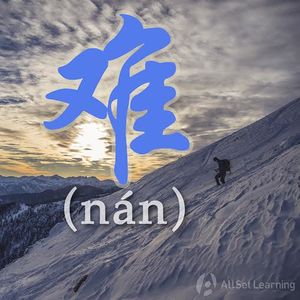Difference between revisions of "Expressing "difficult" with "nan""
(→Books) |
|||
| Line 67: | Line 67: | ||
=== Books === | === Books === | ||
| − | * [[Integrated Chinese: Level 1, Part 2 (3rd ed)]] ( | + | * [[Integrated Chinese: Level 1, Part 2 (3rd ed)]] (p. 232) [http://www.amazon.com/gp/product/0887276709/ref%3das_li_ss_tl?ie=UTF8&tag=allset-20&linkCode=as2&camp=217145&creative=399369&creativeASIN=0887276709 →buy] |
[[Category:A2 grammar points]] | [[Category:A2 grammar points]] | ||
Revision as of 08:44, 21 May 2014
-
Level
-
Similar to
-
Used for
-
Keywords
Whenever something is "hard to do" (as in difficult) or "bad to do" (as in bad experience), the word 难 (nán) can be used.
Contents
难 with General Verbs
Structure
Just as 好 can be used to indicate that it's easy to do something, 难 (nán) can be attached to verbs, except sensitive words, to indicate that something is hard to do. The structure is:
Subject + (很) 难 + Verb
Examples
- 难 懂Hard to understand.
- 这 句 话 很 难 懂。This talk is hard to understand.
- 难 学Hard to learn.
- 汉语 很 难 学。Mandarin is hard to learn.
- 难 做Hard to do.
- 三明治 很 难 做。Sandwiches are hard to make.
- 难 买Hard to buy (as in probably hard to find).
- 这 个 东西 现在 很 难 买。This thing is really difficult to purchase now.
- 难 写Difficult to write.
- 这 个 汉字 很 难 写。This character is very difficult to write.
难 with Sense Verbs
Structure
难 (nán) can also be attached to "sense verbs" (e.g. look, taste, smell, etc.) to indicate that something is bad to do. The structure is:
Subject + (很) 难 + [Sense Verb]
Examples
- 难听Sounds bad(hard to listen to).
- 这 首 歌 很 难听。This song is terrible (This song is hard to listen to).
- 难闻Smells bad. (it stinks)
- 这 只 小 猫 很 难闻。This little cat smells bad.
- 难看Hard to look at (looks bad/ugly).
- 这 件 衣服 很 难看吗?Is this piece of clothing ugly?
- 难吃Disgusting (hard to eat).
- 你 做的菜 很 难吃。The dishes you cook taste bad.



